Analyzing Consumer Behavior and Decision Making: Samsung
VerifiedAdded on 2023/04/07
|23
|4703
|223
Report
AI Summary
This report provides an in-depth analysis of marketing strategies in relation to Samsung, Hong Kong, focusing on consumer behavior and decision-making processes. It examines the stages of the consumer decision-making journey for smartphones, highlighting the importance of mapping the path to purchase for marketers. The report compares and contrasts B2B and B2C approaches, evaluates market research methods, and explores factors influencing buying behavior. Furthermore, it assesses how marketers influence decision-making stages in both B2C and B2B contexts, providing a comprehensive overview of Samsung's marketing strategies and their impact on consumer behavior. Desklib provides access to this and other solved assignments to aid student learning.
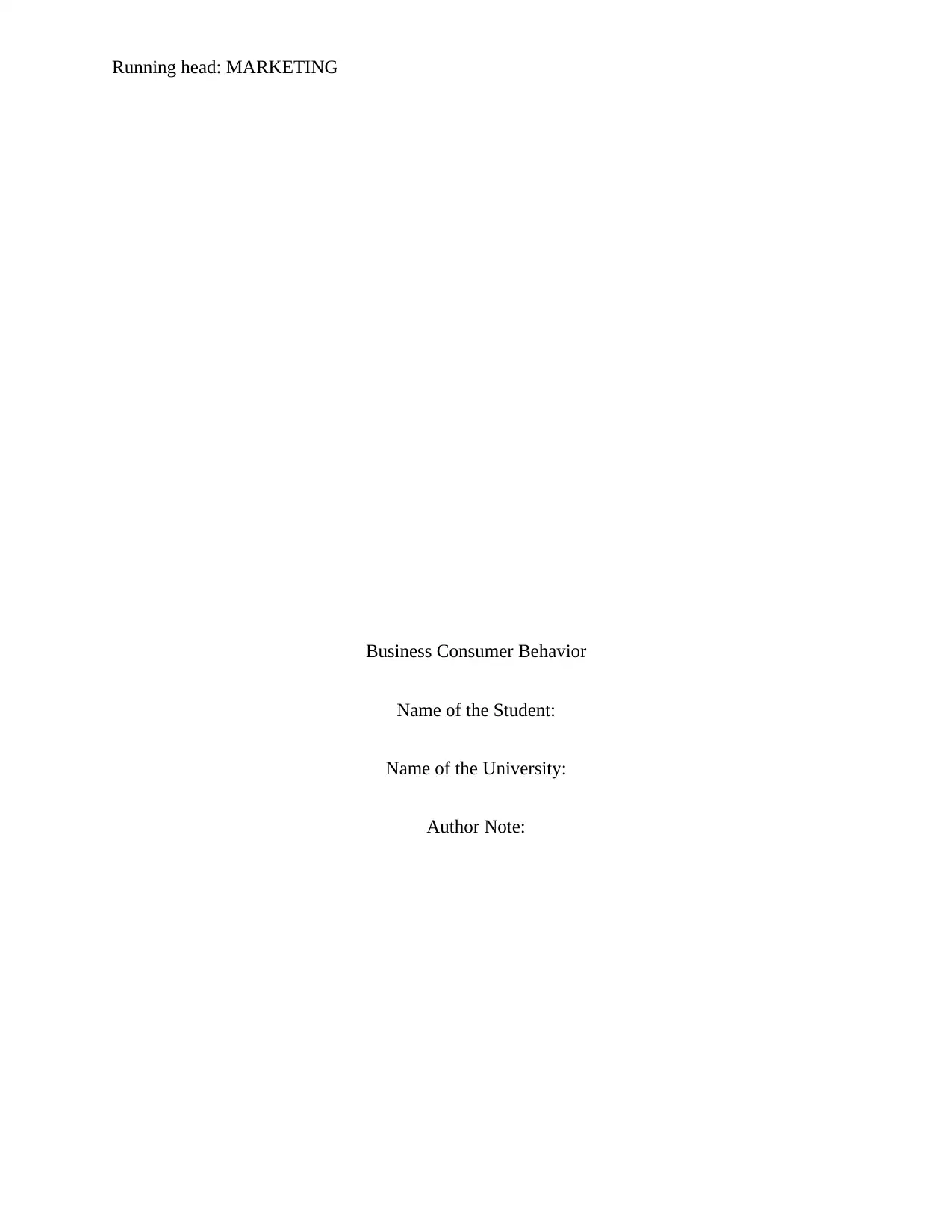
Running head: MARKETING
Business Consumer Behavior
Name of the Student:
Name of the University:
Author Note:
Business Consumer Behavior
Name of the Student:
Name of the University:
Author Note:
Paraphrase This Document
Need a fresh take? Get an instant paraphrase of this document with our AI Paraphraser
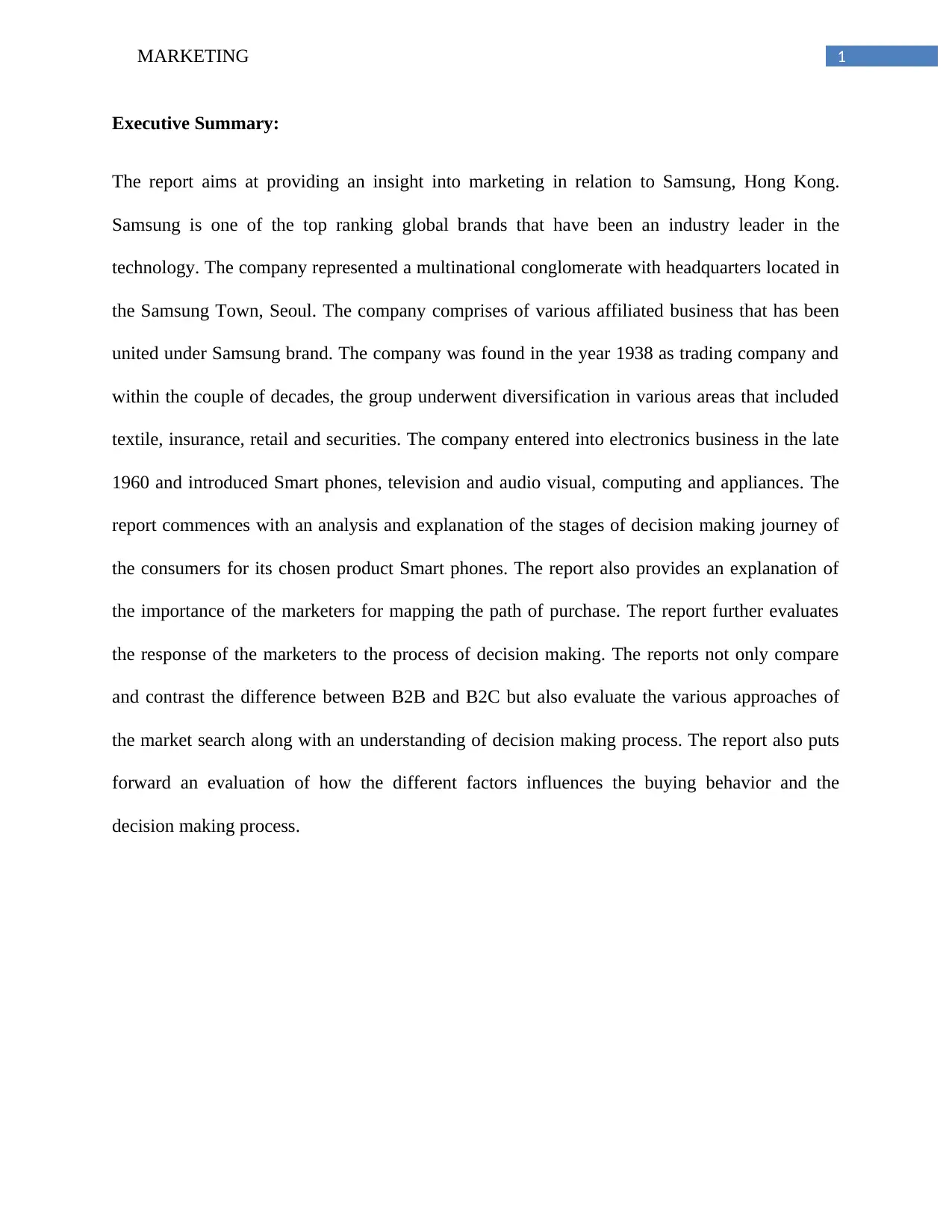
1MARKETING
Executive Summary:
The report aims at providing an insight into marketing in relation to Samsung, Hong Kong.
Samsung is one of the top ranking global brands that have been an industry leader in the
technology. The company represented a multinational conglomerate with headquarters located in
the Samsung Town, Seoul. The company comprises of various affiliated business that has been
united under Samsung brand. The company was found in the year 1938 as trading company and
within the couple of decades, the group underwent diversification in various areas that included
textile, insurance, retail and securities. The company entered into electronics business in the late
1960 and introduced Smart phones, television and audio visual, computing and appliances. The
report commences with an analysis and explanation of the stages of decision making journey of
the consumers for its chosen product Smart phones. The report also provides an explanation of
the importance of the marketers for mapping the path of purchase. The report further evaluates
the response of the marketers to the process of decision making. The reports not only compare
and contrast the difference between B2B and B2C but also evaluate the various approaches of
the market search along with an understanding of decision making process. The report also puts
forward an evaluation of how the different factors influences the buying behavior and the
decision making process.
Executive Summary:
The report aims at providing an insight into marketing in relation to Samsung, Hong Kong.
Samsung is one of the top ranking global brands that have been an industry leader in the
technology. The company represented a multinational conglomerate with headquarters located in
the Samsung Town, Seoul. The company comprises of various affiliated business that has been
united under Samsung brand. The company was found in the year 1938 as trading company and
within the couple of decades, the group underwent diversification in various areas that included
textile, insurance, retail and securities. The company entered into electronics business in the late
1960 and introduced Smart phones, television and audio visual, computing and appliances. The
report commences with an analysis and explanation of the stages of decision making journey of
the consumers for its chosen product Smart phones. The report also provides an explanation of
the importance of the marketers for mapping the path of purchase. The report further evaluates
the response of the marketers to the process of decision making. The reports not only compare
and contrast the difference between B2B and B2C but also evaluate the various approaches of
the market search along with an understanding of decision making process. The report also puts
forward an evaluation of how the different factors influences the buying behavior and the
decision making process.
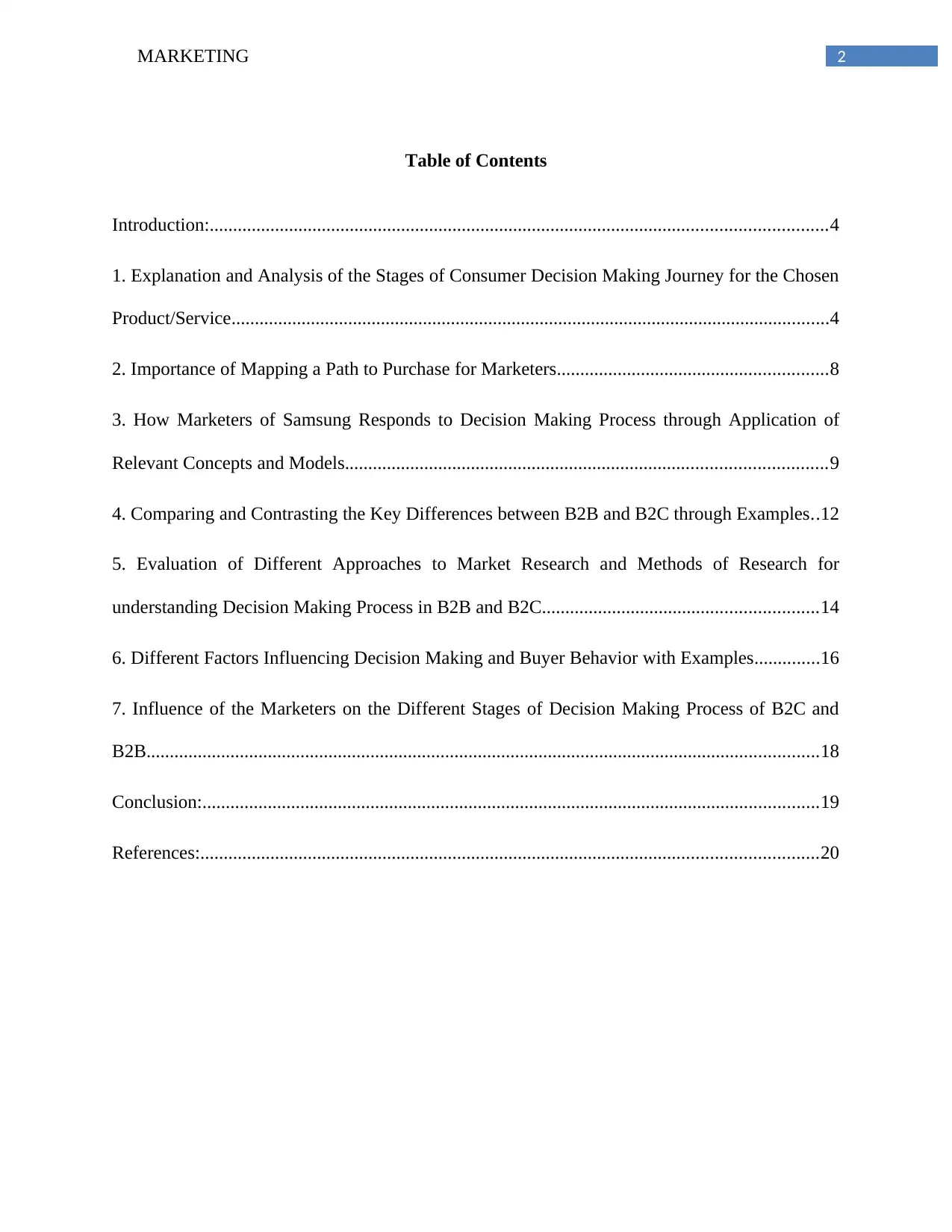
2MARKETING
Table of Contents
Introduction:....................................................................................................................................4
1. Explanation and Analysis of the Stages of Consumer Decision Making Journey for the Chosen
Product/Service................................................................................................................................4
2. Importance of Mapping a Path to Purchase for Marketers..........................................................8
3. How Marketers of Samsung Responds to Decision Making Process through Application of
Relevant Concepts and Models.......................................................................................................9
4. Comparing and Contrasting the Key Differences between B2B and B2C through Examples..12
5. Evaluation of Different Approaches to Market Research and Methods of Research for
understanding Decision Making Process in B2B and B2C...........................................................14
6. Different Factors Influencing Decision Making and Buyer Behavior with Examples..............16
7. Influence of the Marketers on the Different Stages of Decision Making Process of B2C and
B2B................................................................................................................................................18
Conclusion:....................................................................................................................................19
References:....................................................................................................................................20
Table of Contents
Introduction:....................................................................................................................................4
1. Explanation and Analysis of the Stages of Consumer Decision Making Journey for the Chosen
Product/Service................................................................................................................................4
2. Importance of Mapping a Path to Purchase for Marketers..........................................................8
3. How Marketers of Samsung Responds to Decision Making Process through Application of
Relevant Concepts and Models.......................................................................................................9
4. Comparing and Contrasting the Key Differences between B2B and B2C through Examples..12
5. Evaluation of Different Approaches to Market Research and Methods of Research for
understanding Decision Making Process in B2B and B2C...........................................................14
6. Different Factors Influencing Decision Making and Buyer Behavior with Examples..............16
7. Influence of the Marketers on the Different Stages of Decision Making Process of B2C and
B2B................................................................................................................................................18
Conclusion:....................................................................................................................................19
References:....................................................................................................................................20
⊘ This is a preview!⊘
Do you want full access?
Subscribe today to unlock all pages.

Trusted by 1+ million students worldwide
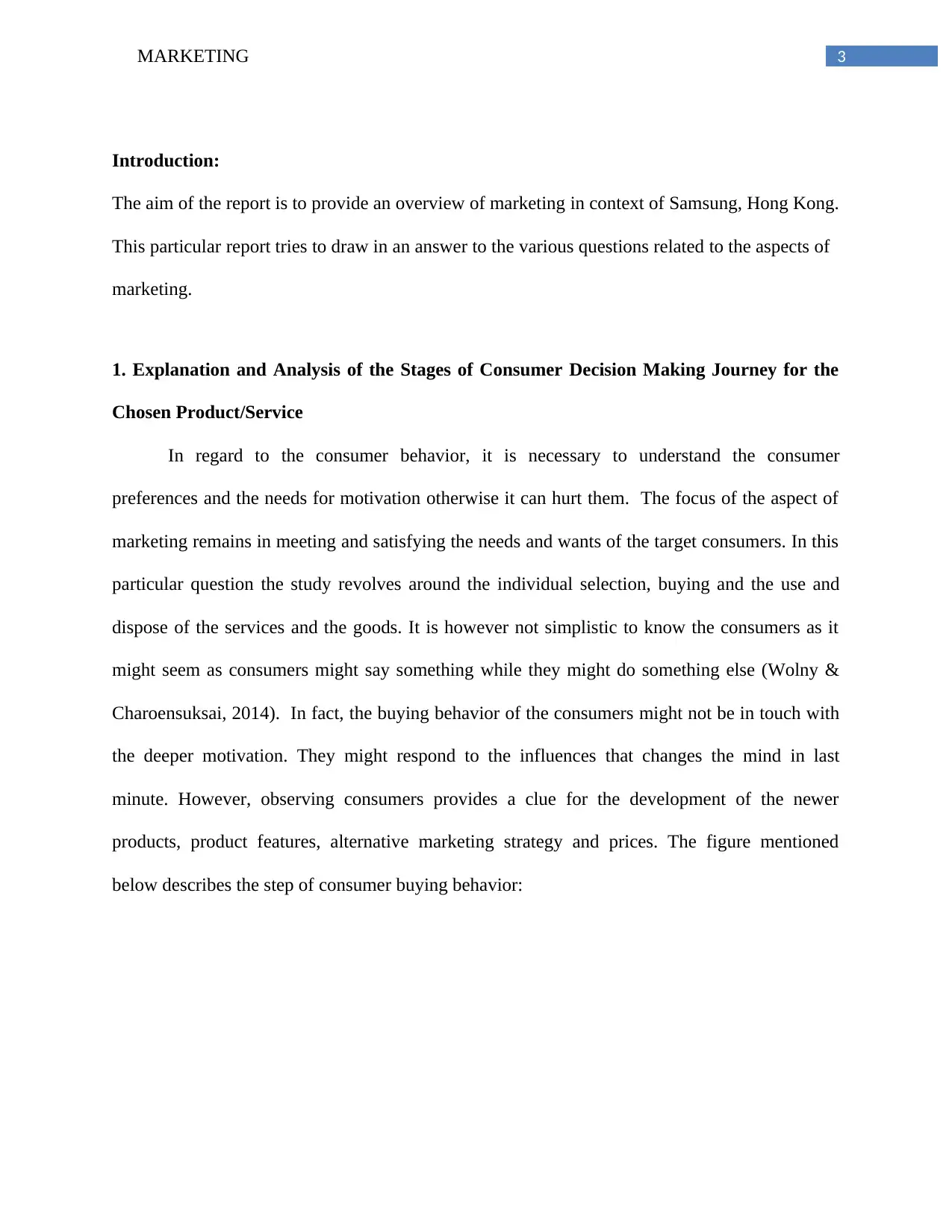
3MARKETING
Introduction:
The aim of the report is to provide an overview of marketing in context of Samsung, Hong Kong.
This particular report tries to draw in an answer to the various questions related to the aspects of
marketing.
1. Explanation and Analysis of the Stages of Consumer Decision Making Journey for the
Chosen Product/Service
In regard to the consumer behavior, it is necessary to understand the consumer
preferences and the needs for motivation otherwise it can hurt them. The focus of the aspect of
marketing remains in meeting and satisfying the needs and wants of the target consumers. In this
particular question the study revolves around the individual selection, buying and the use and
dispose of the services and the goods. It is however not simplistic to know the consumers as it
might seem as consumers might say something while they might do something else (Wolny &
Charoensuksai, 2014). In fact, the buying behavior of the consumers might not be in touch with
the deeper motivation. They might respond to the influences that changes the mind in last
minute. However, observing consumers provides a clue for the development of the newer
products, product features, alternative marketing strategy and prices. The figure mentioned
below describes the step of consumer buying behavior:
Introduction:
The aim of the report is to provide an overview of marketing in context of Samsung, Hong Kong.
This particular report tries to draw in an answer to the various questions related to the aspects of
marketing.
1. Explanation and Analysis of the Stages of Consumer Decision Making Journey for the
Chosen Product/Service
In regard to the consumer behavior, it is necessary to understand the consumer
preferences and the needs for motivation otherwise it can hurt them. The focus of the aspect of
marketing remains in meeting and satisfying the needs and wants of the target consumers. In this
particular question the study revolves around the individual selection, buying and the use and
dispose of the services and the goods. It is however not simplistic to know the consumers as it
might seem as consumers might say something while they might do something else (Wolny &
Charoensuksai, 2014). In fact, the buying behavior of the consumers might not be in touch with
the deeper motivation. They might respond to the influences that changes the mind in last
minute. However, observing consumers provides a clue for the development of the newer
products, product features, alternative marketing strategy and prices. The figure mentioned
below describes the step of consumer buying behavior:
Paraphrase This Document
Need a fresh take? Get an instant paraphrase of this document with our AI Paraphraser
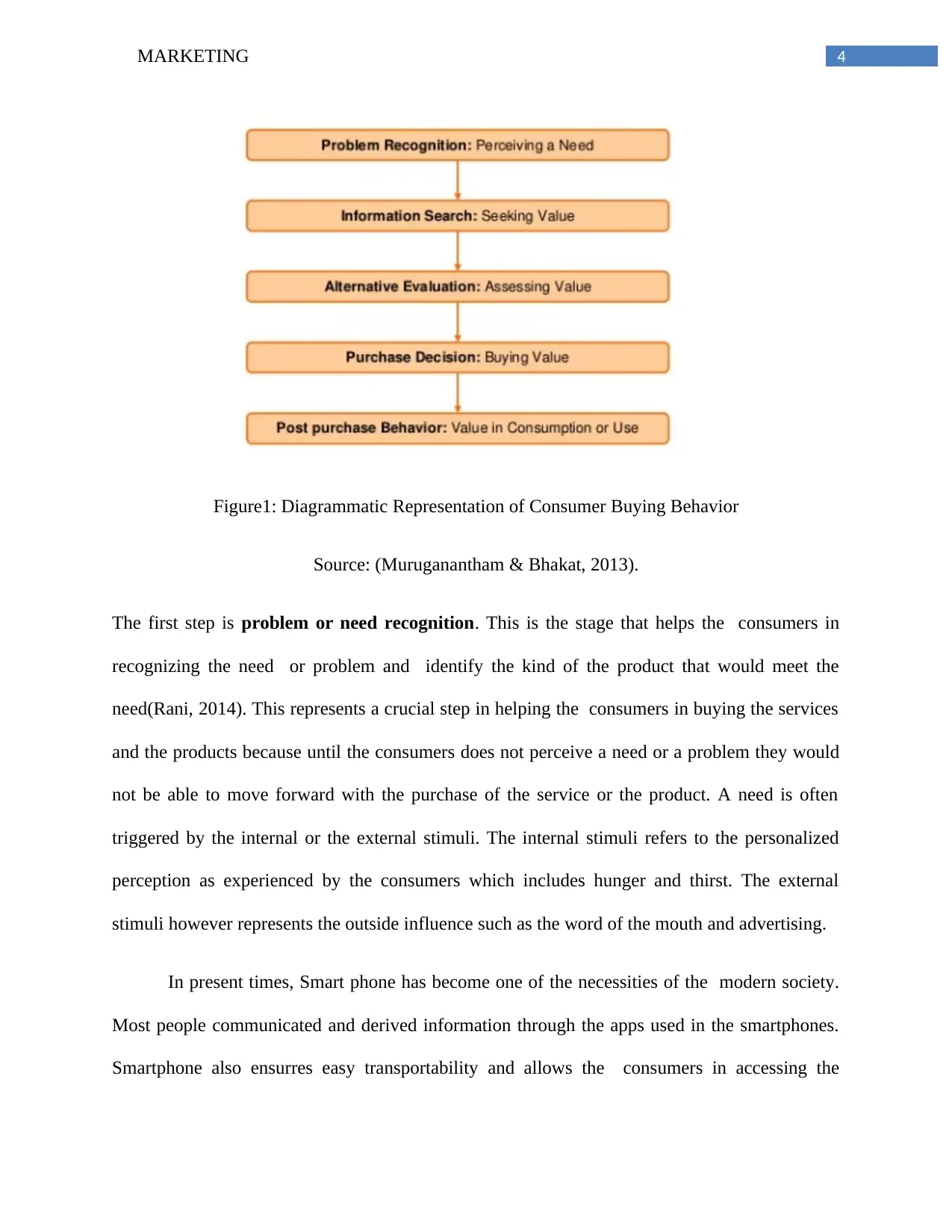
4MARKETING
Figure1: Diagrammatic Representation of Consumer Buying Behavior
Source: (Muruganantham & Bhakat, 2013).
The first step is problem or need recognition. This is the stage that helps the consumers in
recognizing the need or problem and identify the kind of the product that would meet the
need(Rani, 2014). This represents a crucial step in helping the consumers in buying the services
and the products because until the consumers does not perceive a need or a problem they would
not be able to move forward with the purchase of the service or the product. A need is often
triggered by the internal or the external stimuli. The internal stimuli refers to the personalized
perception as experienced by the consumers which includes hunger and thirst. The external
stimuli however represents the outside influence such as the word of the mouth and advertising.
In present times, Smart phone has become one of the necessities of the modern society.
Most people communicated and derived information through the apps used in the smartphones.
Smartphone also ensurres easy transportability and allows the consumers in accessing the
Figure1: Diagrammatic Representation of Consumer Buying Behavior
Source: (Muruganantham & Bhakat, 2013).
The first step is problem or need recognition. This is the stage that helps the consumers in
recognizing the need or problem and identify the kind of the product that would meet the
need(Rani, 2014). This represents a crucial step in helping the consumers in buying the services
and the products because until the consumers does not perceive a need or a problem they would
not be able to move forward with the purchase of the service or the product. A need is often
triggered by the internal or the external stimuli. The internal stimuli refers to the personalized
perception as experienced by the consumers which includes hunger and thirst. The external
stimuli however represents the outside influence such as the word of the mouth and advertising.
In present times, Smart phone has become one of the necessities of the modern society.
Most people communicated and derived information through the apps used in the smartphones.
Smartphone also ensurres easy transportability and allows the consumers in accessing the
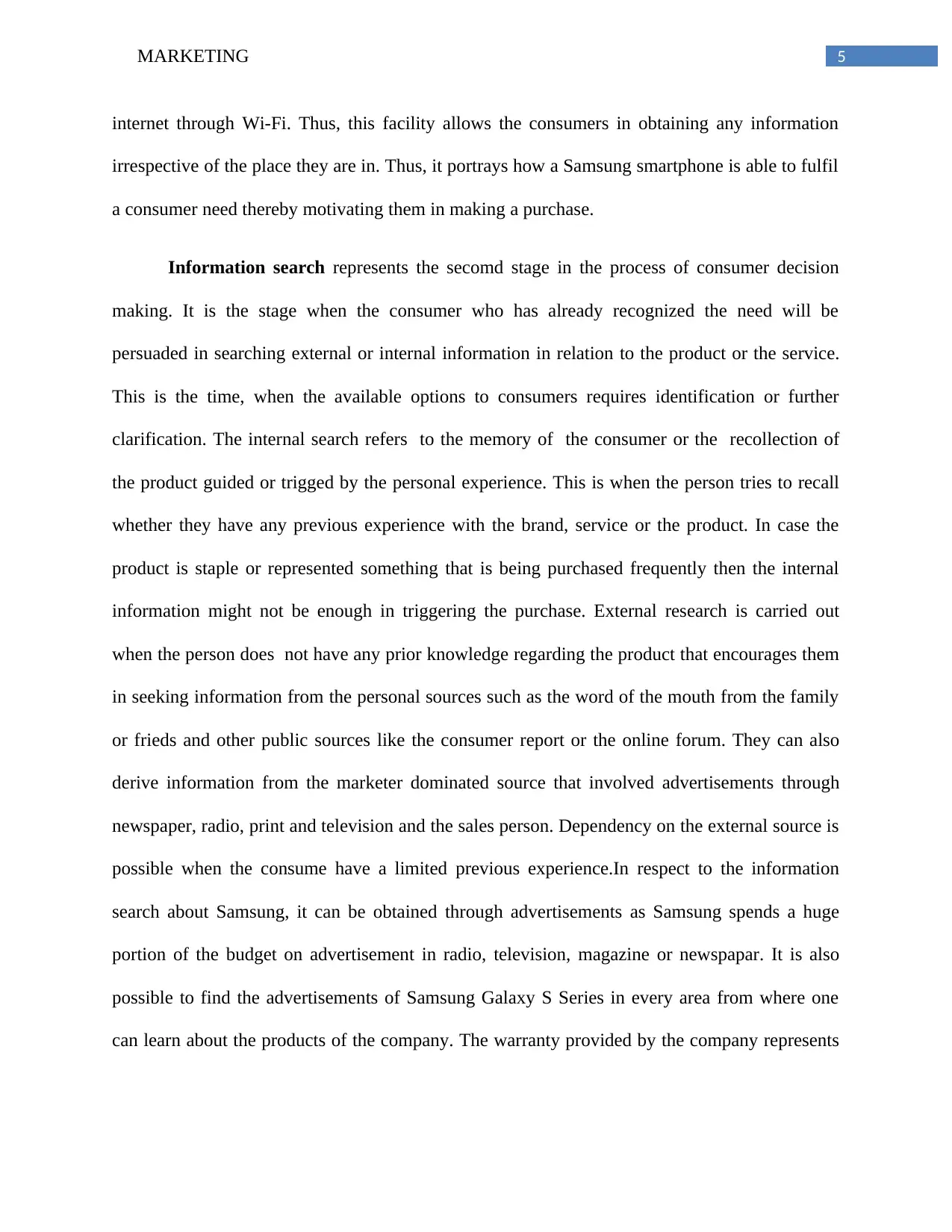
5MARKETING
internet through Wi-Fi. Thus, this facility allows the consumers in obtaining any information
irrespective of the place they are in. Thus, it portrays how a Samsung smartphone is able to fulfil
a consumer need thereby motivating them in making a purchase.
Information search represents the secomd stage in the process of consumer decision
making. It is the stage when the consumer who has already recognized the need will be
persuaded in searching external or internal information in relation to the product or the service.
This is the time, when the available options to consumers requires identification or further
clarification. The internal search refers to the memory of the consumer or the recollection of
the product guided or trigged by the personal experience. This is when the person tries to recall
whether they have any previous experience with the brand, service or the product. In case the
product is staple or represented something that is being purchased frequently then the internal
information might not be enough in triggering the purchase. External research is carried out
when the person does not have any prior knowledge regarding the product that encourages them
in seeking information from the personal sources such as the word of the mouth from the family
or frieds and other public sources like the consumer report or the online forum. They can also
derive information from the marketer dominated source that involved advertisements through
newspaper, radio, print and television and the sales person. Dependency on the external source is
possible when the consume have a limited previous experience.In respect to the information
search about Samsung, it can be obtained through advertisements as Samsung spends a huge
portion of the budget on advertisement in radio, television, magazine or newspapar. It is also
possible to find the advertisements of Samsung Galaxy S Series in every area from where one
can learn about the products of the company. The warranty provided by the company represents
internet through Wi-Fi. Thus, this facility allows the consumers in obtaining any information
irrespective of the place they are in. Thus, it portrays how a Samsung smartphone is able to fulfil
a consumer need thereby motivating them in making a purchase.
Information search represents the secomd stage in the process of consumer decision
making. It is the stage when the consumer who has already recognized the need will be
persuaded in searching external or internal information in relation to the product or the service.
This is the time, when the available options to consumers requires identification or further
clarification. The internal search refers to the memory of the consumer or the recollection of
the product guided or trigged by the personal experience. This is when the person tries to recall
whether they have any previous experience with the brand, service or the product. In case the
product is staple or represented something that is being purchased frequently then the internal
information might not be enough in triggering the purchase. External research is carried out
when the person does not have any prior knowledge regarding the product that encourages them
in seeking information from the personal sources such as the word of the mouth from the family
or frieds and other public sources like the consumer report or the online forum. They can also
derive information from the marketer dominated source that involved advertisements through
newspaper, radio, print and television and the sales person. Dependency on the external source is
possible when the consume have a limited previous experience.In respect to the information
search about Samsung, it can be obtained through advertisements as Samsung spends a huge
portion of the budget on advertisement in radio, television, magazine or newspapar. It is also
possible to find the advertisements of Samsung Galaxy S Series in every area from where one
can learn about the products of the company. The warranty provided by the company represents
⊘ This is a preview!⊘
Do you want full access?
Subscribe today to unlock all pages.

Trusted by 1+ million students worldwide
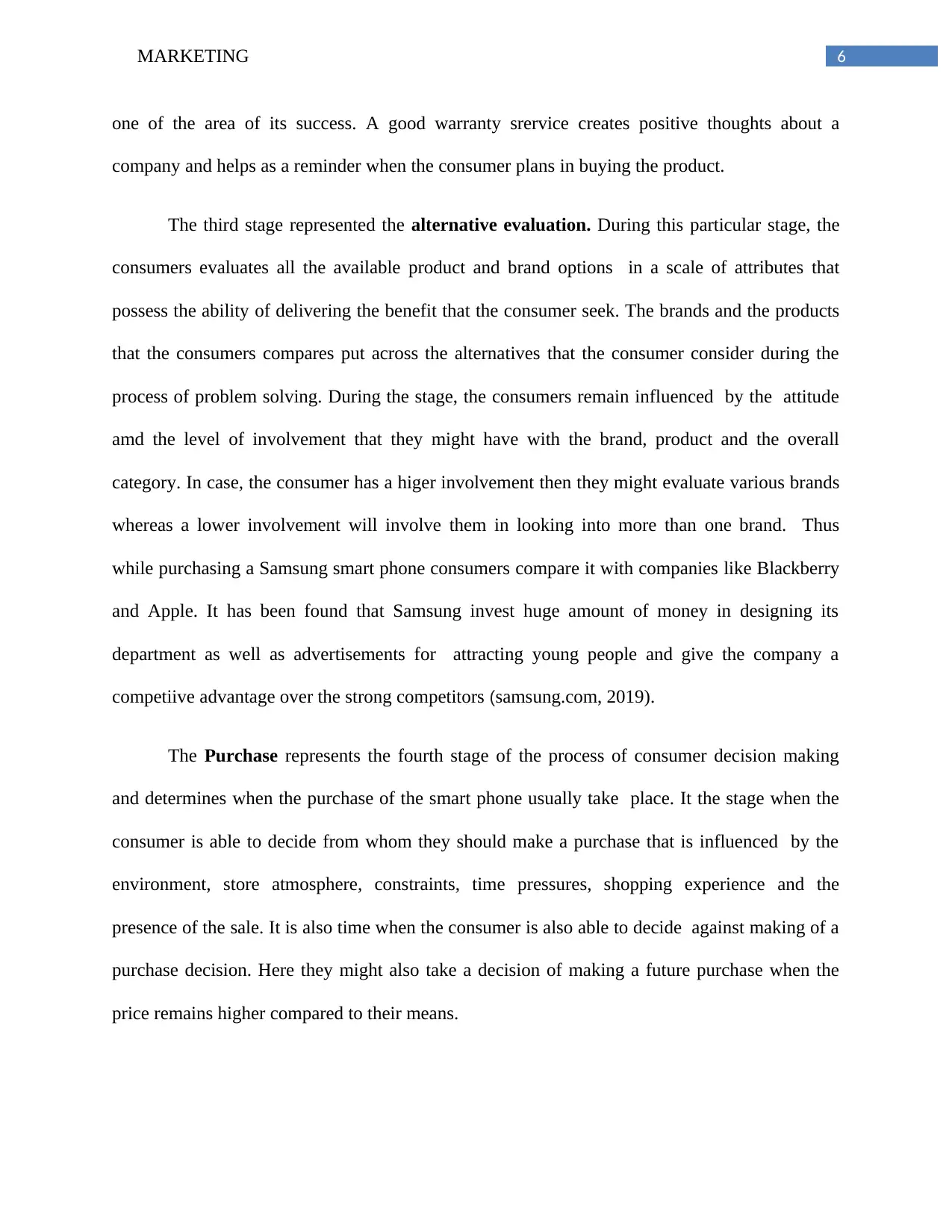
6MARKETING
one of the area of its success. A good warranty srervice creates positive thoughts about a
company and helps as a reminder when the consumer plans in buying the product.
The third stage represented the alternative evaluation. During this particular stage, the
consumers evaluates all the available product and brand options in a scale of attributes that
possess the ability of delivering the benefit that the consumer seek. The brands and the products
that the consumers compares put across the alternatives that the consumer consider during the
process of problem solving. During the stage, the consumers remain influenced by the attitude
amd the level of involvement that they might have with the brand, product and the overall
category. In case, the consumer has a higer involvement then they might evaluate various brands
whereas a lower involvement will involve them in looking into more than one brand. Thus
while purchasing a Samsung smart phone consumers compare it with companies like Blackberry
and Apple. It has been found that Samsung invest huge amount of money in designing its
department as well as advertisements for attracting young people and give the company a
competiive advantage over the strong competitors (samsung.com, 2019).
The Purchase represents the fourth stage of the process of consumer decision making
and determines when the purchase of the smart phone usually take place. It the stage when the
consumer is able to decide from whom they should make a purchase that is influenced by the
environment, store atmosphere, constraints, time pressures, shopping experience and the
presence of the sale. It is also time when the consumer is also able to decide against making of a
purchase decision. Here they might also take a decision of making a future purchase when the
price remains higher compared to their means.
one of the area of its success. A good warranty srervice creates positive thoughts about a
company and helps as a reminder when the consumer plans in buying the product.
The third stage represented the alternative evaluation. During this particular stage, the
consumers evaluates all the available product and brand options in a scale of attributes that
possess the ability of delivering the benefit that the consumer seek. The brands and the products
that the consumers compares put across the alternatives that the consumer consider during the
process of problem solving. During the stage, the consumers remain influenced by the attitude
amd the level of involvement that they might have with the brand, product and the overall
category. In case, the consumer has a higer involvement then they might evaluate various brands
whereas a lower involvement will involve them in looking into more than one brand. Thus
while purchasing a Samsung smart phone consumers compare it with companies like Blackberry
and Apple. It has been found that Samsung invest huge amount of money in designing its
department as well as advertisements for attracting young people and give the company a
competiive advantage over the strong competitors (samsung.com, 2019).
The Purchase represents the fourth stage of the process of consumer decision making
and determines when the purchase of the smart phone usually take place. It the stage when the
consumer is able to decide from whom they should make a purchase that is influenced by the
environment, store atmosphere, constraints, time pressures, shopping experience and the
presence of the sale. It is also time when the consumer is also able to decide against making of a
purchase decision. Here they might also take a decision of making a future purchase when the
price remains higher compared to their means.
Paraphrase This Document
Need a fresh take? Get an instant paraphrase of this document with our AI Paraphraser
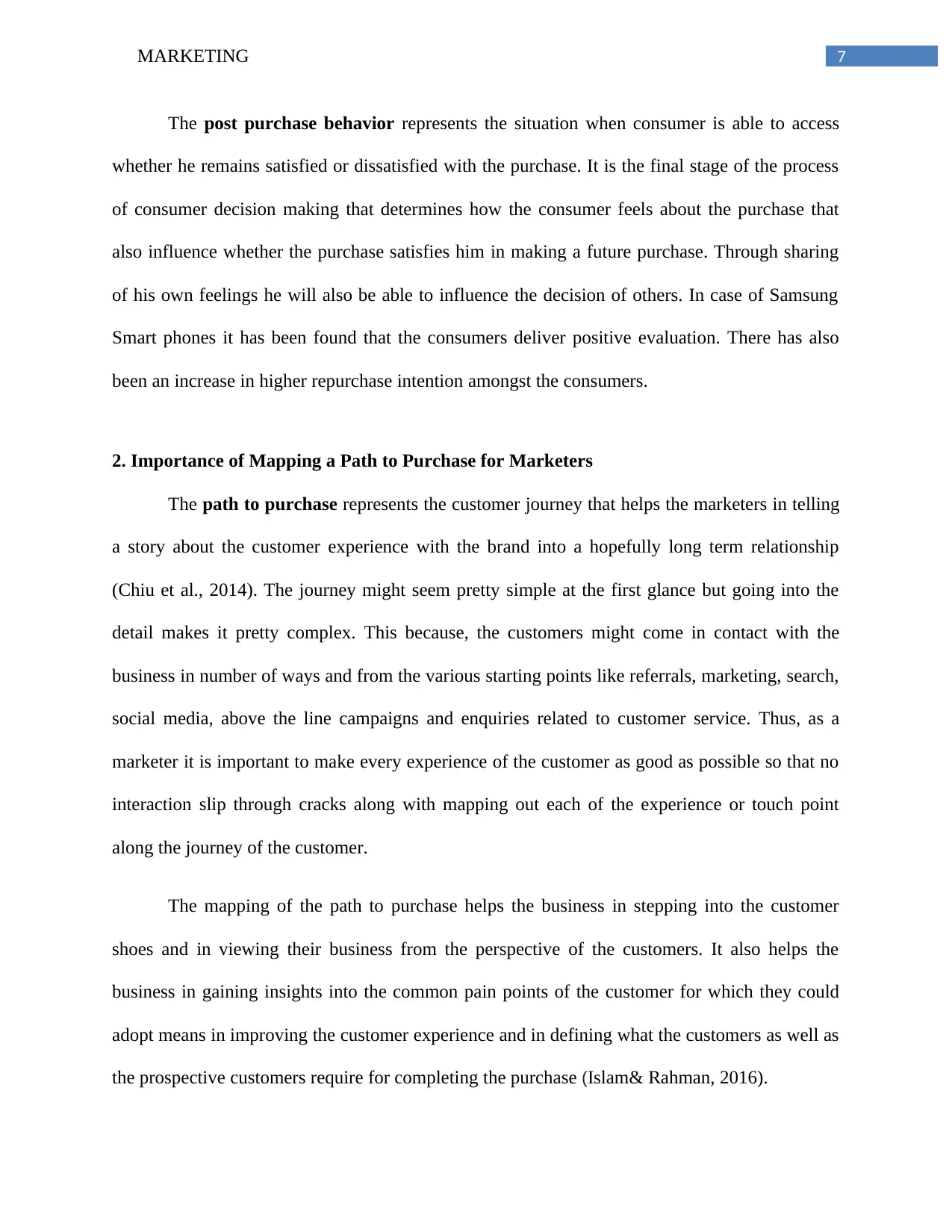
7MARKETING
The post purchase behavior represents the situation when consumer is able to access
whether he remains satisfied or dissatisfied with the purchase. It is the final stage of the process
of consumer decision making that determines how the consumer feels about the purchase that
also influence whether the purchase satisfies him in making a future purchase. Through sharing
of his own feelings he will also be able to influence the decision of others. In case of Samsung
Smart phones it has been found that the consumers deliver positive evaluation. There has also
been an increase in higher repurchase intention amongst the consumers.
2. Importance of Mapping a Path to Purchase for Marketers
The path to purchase represents the customer journey that helps the marketers in telling
a story about the customer experience with the brand into a hopefully long term relationship
(Chiu et al., 2014). The journey might seem pretty simple at the first glance but going into the
detail makes it pretty complex. This because, the customers might come in contact with the
business in number of ways and from the various starting points like referrals, marketing, search,
social media, above the line campaigns and enquiries related to customer service. Thus, as a
marketer it is important to make every experience of the customer as good as possible so that no
interaction slip through cracks along with mapping out each of the experience or touch point
along the journey of the customer.
The mapping of the path to purchase helps the business in stepping into the customer
shoes and in viewing their business from the perspective of the customers. It also helps the
business in gaining insights into the common pain points of the customer for which they could
adopt means in improving the customer experience and in defining what the customers as well as
the prospective customers require for completing the purchase (Islam& Rahman, 2016).
The post purchase behavior represents the situation when consumer is able to access
whether he remains satisfied or dissatisfied with the purchase. It is the final stage of the process
of consumer decision making that determines how the consumer feels about the purchase that
also influence whether the purchase satisfies him in making a future purchase. Through sharing
of his own feelings he will also be able to influence the decision of others. In case of Samsung
Smart phones it has been found that the consumers deliver positive evaluation. There has also
been an increase in higher repurchase intention amongst the consumers.
2. Importance of Mapping a Path to Purchase for Marketers
The path to purchase represents the customer journey that helps the marketers in telling
a story about the customer experience with the brand into a hopefully long term relationship
(Chiu et al., 2014). The journey might seem pretty simple at the first glance but going into the
detail makes it pretty complex. This because, the customers might come in contact with the
business in number of ways and from the various starting points like referrals, marketing, search,
social media, above the line campaigns and enquiries related to customer service. Thus, as a
marketer it is important to make every experience of the customer as good as possible so that no
interaction slip through cracks along with mapping out each of the experience or touch point
along the journey of the customer.
The mapping of the path to purchase helps the business in stepping into the customer
shoes and in viewing their business from the perspective of the customers. It also helps the
business in gaining insights into the common pain points of the customer for which they could
adopt means in improving the customer experience and in defining what the customers as well as
the prospective customers require for completing the purchase (Islam& Rahman, 2016).
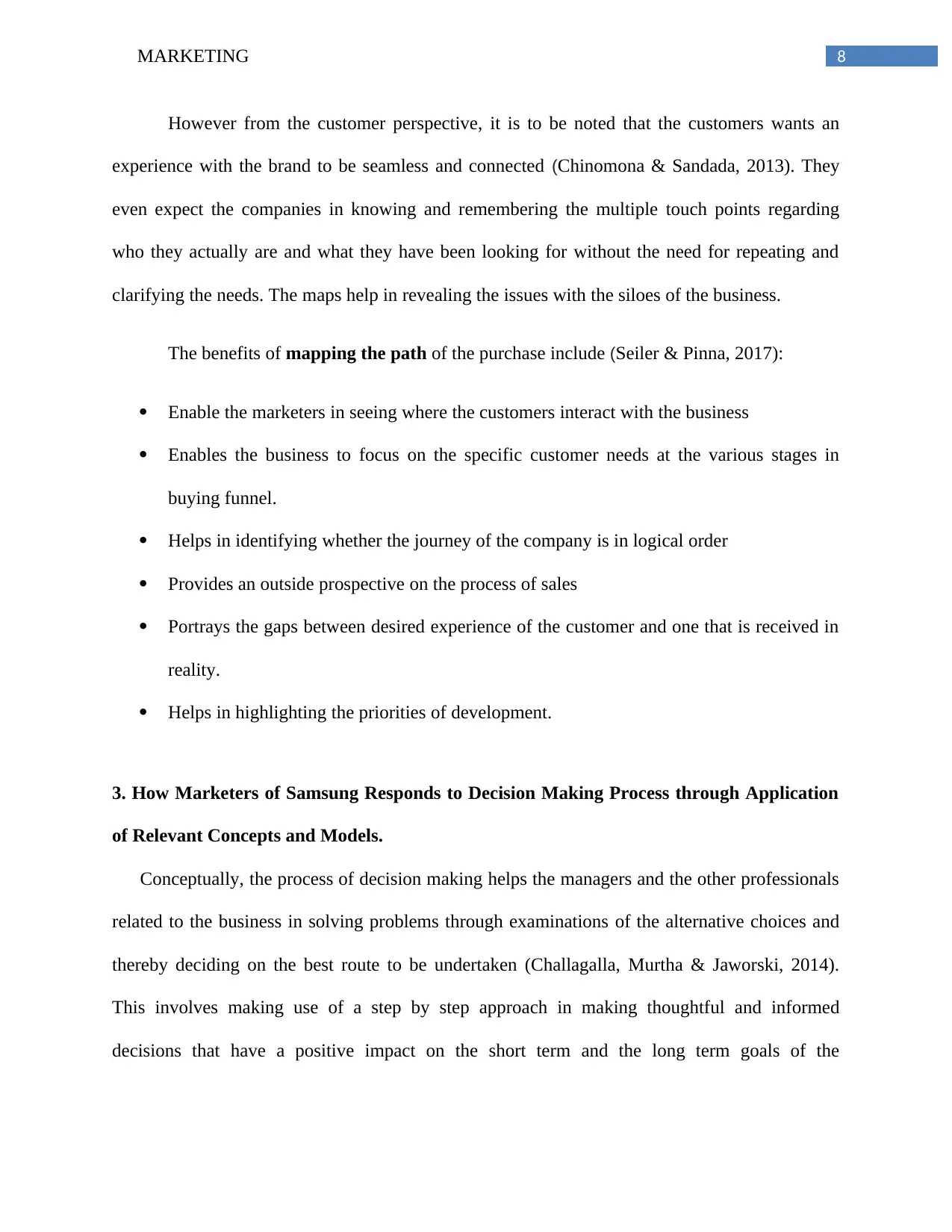
8MARKETING
However from the customer perspective, it is to be noted that the customers wants an
experience with the brand to be seamless and connected (Chinomona & Sandada, 2013). They
even expect the companies in knowing and remembering the multiple touch points regarding
who they actually are and what they have been looking for without the need for repeating and
clarifying the needs. The maps help in revealing the issues with the siloes of the business.
The benefits of mapping the path of the purchase include (Seiler & Pinna, 2017):
Enable the marketers in seeing where the customers interact with the business
Enables the business to focus on the specific customer needs at the various stages in
buying funnel.
Helps in identifying whether the journey of the company is in logical order
Provides an outside prospective on the process of sales
Portrays the gaps between desired experience of the customer and one that is received in
reality.
Helps in highlighting the priorities of development.
3. How Marketers of Samsung Responds to Decision Making Process through Application
of Relevant Concepts and Models.
Conceptually, the process of decision making helps the managers and the other professionals
related to the business in solving problems through examinations of the alternative choices and
thereby deciding on the best route to be undertaken (Challagalla, Murtha & Jaworski, 2014).
This involves making use of a step by step approach in making thoughtful and informed
decisions that have a positive impact on the short term and the long term goals of the
However from the customer perspective, it is to be noted that the customers wants an
experience with the brand to be seamless and connected (Chinomona & Sandada, 2013). They
even expect the companies in knowing and remembering the multiple touch points regarding
who they actually are and what they have been looking for without the need for repeating and
clarifying the needs. The maps help in revealing the issues with the siloes of the business.
The benefits of mapping the path of the purchase include (Seiler & Pinna, 2017):
Enable the marketers in seeing where the customers interact with the business
Enables the business to focus on the specific customer needs at the various stages in
buying funnel.
Helps in identifying whether the journey of the company is in logical order
Provides an outside prospective on the process of sales
Portrays the gaps between desired experience of the customer and one that is received in
reality.
Helps in highlighting the priorities of development.
3. How Marketers of Samsung Responds to Decision Making Process through Application
of Relevant Concepts and Models.
Conceptually, the process of decision making helps the managers and the other professionals
related to the business in solving problems through examinations of the alternative choices and
thereby deciding on the best route to be undertaken (Challagalla, Murtha & Jaworski, 2014).
This involves making use of a step by step approach in making thoughtful and informed
decisions that have a positive impact on the short term and the long term goals of the
⊘ This is a preview!⊘
Do you want full access?
Subscribe today to unlock all pages.

Trusted by 1+ million students worldwide
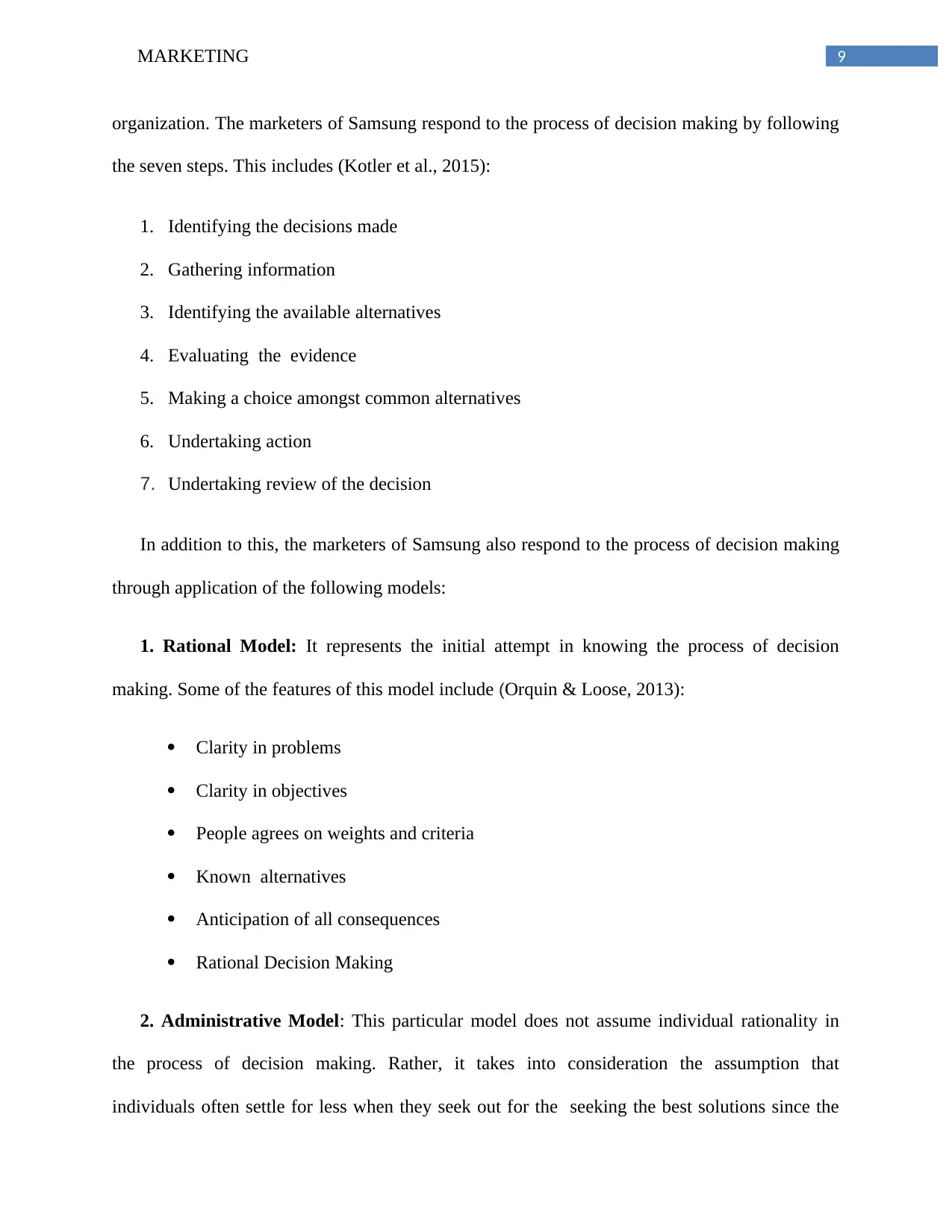
9MARKETING
organization. The marketers of Samsung respond to the process of decision making by following
the seven steps. This includes (Kotler et al., 2015):
1. Identifying the decisions made
2. Gathering information
3. Identifying the available alternatives
4. Evaluating the evidence
5. Making a choice amongst common alternatives
6. Undertaking action
7. Undertaking review of the decision
In addition to this, the marketers of Samsung also respond to the process of decision making
through application of the following models:
1. Rational Model: It represents the initial attempt in knowing the process of decision
making. Some of the features of this model include (Orquin & Loose, 2013):
Clarity in problems
Clarity in objectives
People agrees on weights and criteria
Known alternatives
Anticipation of all consequences
Rational Decision Making
2. Administrative Model: This particular model does not assume individual rationality in
the process of decision making. Rather, it takes into consideration the assumption that
individuals often settle for less when they seek out for the seeking the best solutions since the
organization. The marketers of Samsung respond to the process of decision making by following
the seven steps. This includes (Kotler et al., 2015):
1. Identifying the decisions made
2. Gathering information
3. Identifying the available alternatives
4. Evaluating the evidence
5. Making a choice amongst common alternatives
6. Undertaking action
7. Undertaking review of the decision
In addition to this, the marketers of Samsung also respond to the process of decision making
through application of the following models:
1. Rational Model: It represents the initial attempt in knowing the process of decision
making. Some of the features of this model include (Orquin & Loose, 2013):
Clarity in problems
Clarity in objectives
People agrees on weights and criteria
Known alternatives
Anticipation of all consequences
Rational Decision Making
2. Administrative Model: This particular model does not assume individual rationality in
the process of decision making. Rather, it takes into consideration the assumption that
individuals often settle for less when they seek out for the seeking the best solutions since the
Paraphrase This Document
Need a fresh take? Get an instant paraphrase of this document with our AI Paraphraser
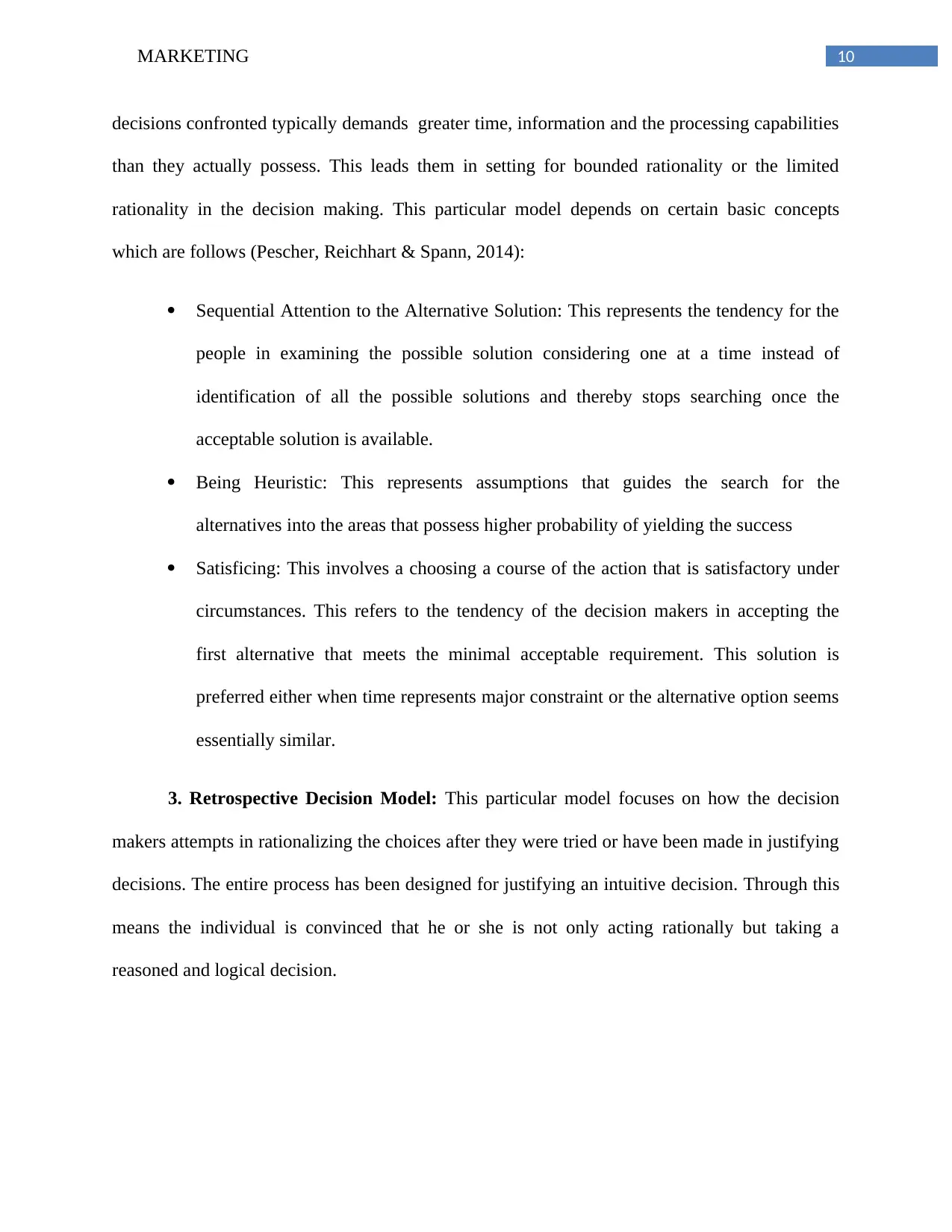
10MARKETING
decisions confronted typically demands greater time, information and the processing capabilities
than they actually possess. This leads them in setting for bounded rationality or the limited
rationality in the decision making. This particular model depends on certain basic concepts
which are follows (Pescher, Reichhart & Spann, 2014):
Sequential Attention to the Alternative Solution: This represents the tendency for the
people in examining the possible solution considering one at a time instead of
identification of all the possible solutions and thereby stops searching once the
acceptable solution is available.
Being Heuristic: This represents assumptions that guides the search for the
alternatives into the areas that possess higher probability of yielding the success
Satisficing: This involves a choosing a course of the action that is satisfactory under
circumstances. This refers to the tendency of the decision makers in accepting the
first alternative that meets the minimal acceptable requirement. This solution is
preferred either when time represents major constraint or the alternative option seems
essentially similar.
3. Retrospective Decision Model: This particular model focuses on how the decision
makers attempts in rationalizing the choices after they were tried or have been made in justifying
decisions. The entire process has been designed for justifying an intuitive decision. Through this
means the individual is convinced that he or she is not only acting rationally but taking a
reasoned and logical decision.
decisions confronted typically demands greater time, information and the processing capabilities
than they actually possess. This leads them in setting for bounded rationality or the limited
rationality in the decision making. This particular model depends on certain basic concepts
which are follows (Pescher, Reichhart & Spann, 2014):
Sequential Attention to the Alternative Solution: This represents the tendency for the
people in examining the possible solution considering one at a time instead of
identification of all the possible solutions and thereby stops searching once the
acceptable solution is available.
Being Heuristic: This represents assumptions that guides the search for the
alternatives into the areas that possess higher probability of yielding the success
Satisficing: This involves a choosing a course of the action that is satisfactory under
circumstances. This refers to the tendency of the decision makers in accepting the
first alternative that meets the minimal acceptable requirement. This solution is
preferred either when time represents major constraint or the alternative option seems
essentially similar.
3. Retrospective Decision Model: This particular model focuses on how the decision
makers attempts in rationalizing the choices after they were tried or have been made in justifying
decisions. The entire process has been designed for justifying an intuitive decision. Through this
means the individual is convinced that he or she is not only acting rationally but taking a
reasoned and logical decision.
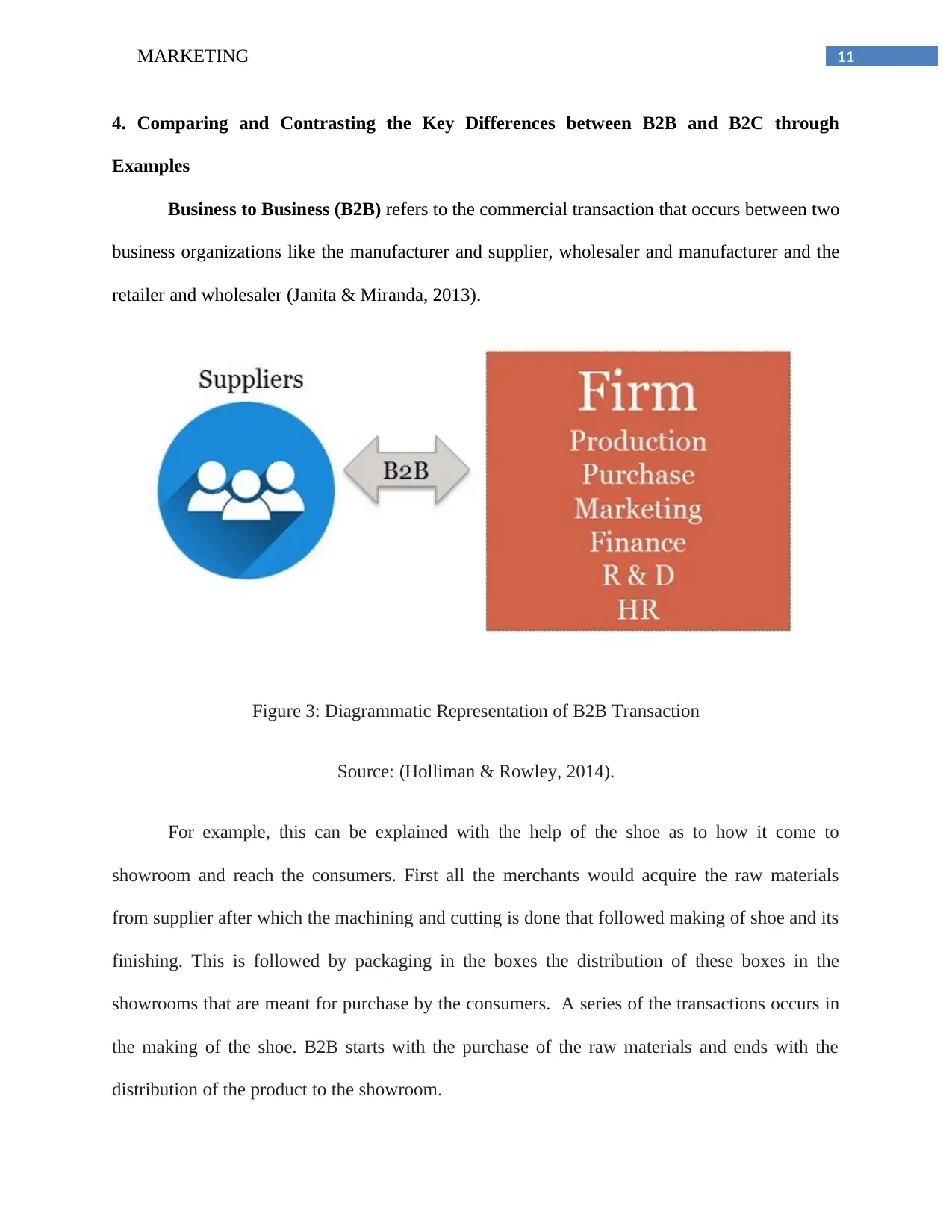
11MARKETING
4. Comparing and Contrasting the Key Differences between B2B and B2C through
Examples
Business to Business (B2B) refers to the commercial transaction that occurs between two
business organizations like the manufacturer and supplier, wholesaler and manufacturer and the
retailer and wholesaler (Janita & Miranda, 2013).
Figure 3: Diagrammatic Representation of B2B Transaction
Source: (Holliman & Rowley, 2014).
For example, this can be explained with the help of the shoe as to how it come to
showroom and reach the consumers. First all the merchants would acquire the raw materials
from supplier after which the machining and cutting is done that followed making of shoe and its
finishing. This is followed by packaging in the boxes the distribution of these boxes in the
showrooms that are meant for purchase by the consumers. A series of the transactions occurs in
the making of the shoe. B2B starts with the purchase of the raw materials and ends with the
distribution of the product to the showroom.
4. Comparing and Contrasting the Key Differences between B2B and B2C through
Examples
Business to Business (B2B) refers to the commercial transaction that occurs between two
business organizations like the manufacturer and supplier, wholesaler and manufacturer and the
retailer and wholesaler (Janita & Miranda, 2013).
Figure 3: Diagrammatic Representation of B2B Transaction
Source: (Holliman & Rowley, 2014).
For example, this can be explained with the help of the shoe as to how it come to
showroom and reach the consumers. First all the merchants would acquire the raw materials
from supplier after which the machining and cutting is done that followed making of shoe and its
finishing. This is followed by packaging in the boxes the distribution of these boxes in the
showrooms that are meant for purchase by the consumers. A series of the transactions occurs in
the making of the shoe. B2B starts with the purchase of the raw materials and ends with the
distribution of the product to the showroom.
⊘ This is a preview!⊘
Do you want full access?
Subscribe today to unlock all pages.

Trusted by 1+ million students worldwide
1 out of 23
Related Documents
Your All-in-One AI-Powered Toolkit for Academic Success.
+13062052269
info@desklib.com
Available 24*7 on WhatsApp / Email
![[object Object]](/_next/static/media/star-bottom.7253800d.svg)
Unlock your academic potential
Copyright © 2020–2025 A2Z Services. All Rights Reserved. Developed and managed by ZUCOL.




